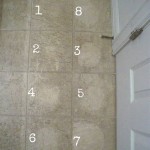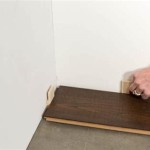Vinyl Flooring Over Concrete Basement: A Comprehensive Guide
Concrete basements, while providing a durable foundation for a structure, often present unique challenges when it comes to flooring. The inherent coolness, potential for moisture, and uneven surfaces require careful consideration when selecting a suitable floor covering. Vinyl flooring has emerged as a popular choice for basement applications due to its water resistance, durability, and relatively easy installation. This article will provide a detailed examination of installing vinyl flooring over a concrete basement, covering essential preparation steps, different types of vinyl options, and best practices for a successful installation.
The decision to install vinyl flooring in a basement must be approached with a thorough understanding of the existing concrete slab's condition. A critical initial step involves assessing the slab for moisture content, cracks, and levelness. Addressing these issues before installation is paramount to ensuring the longevity and performance of the vinyl flooring.
Assessing and Preparing the Concrete Slab
A successful vinyl flooring installation hinges on a properly prepared concrete subfloor. Ignoring this crucial step can lead to a variety of problems, including adhesive failure, mold growth, and uneven flooring surfaces. The assessment process should focus on three key areas: moisture, surface irregularities, and cleanliness.
Moisture is a primary concern in concrete basements. Concrete is porous and can absorb moisture from the surrounding soil. Excess moisture trapped beneath the vinyl flooring can promote mold and mildew growth, leading to unpleasant odors and potential health concerns. Before installing any flooring, it is essential to test the concrete for moisture content. Several methods exist for this purpose, including the calcium chloride test and the relative humidity test. The calcium chloride test involves placing a pre-weighed dish of calcium chloride on the concrete surface, sealing it under a dome, and then weighing it again after a specific period. The weight gain indicates the amount of moisture absorbed by the calcium chloride. The relative humidity test uses a probe inserted into small holes drilled into the concrete to measure the relative humidity levels within the slab. Both tests provide valuable information about the moisture content of the concrete. If moisture levels are excessively high, remediation measures, such as applying a moisture barrier or installing a dehumidifier, are necessary before proceeding with the vinyl flooring installation.
Surface irregularities, such as cracks, divots, and unevenness, must be addressed to provide a smooth and level base for the vinyl flooring. Small cracks can typically be filled with a concrete patching compound formulated for this purpose. Larger cracks may require more extensive repairs, potentially involving the application of a self-leveling compound. Self-leveling compounds are cement-based mixtures that can be poured onto the concrete surface and will spread to create a perfectly level surface. When applying a self-leveling compound, it is crucial to follow the manufacturer's instructions carefully, including proper mixing ratios and curing times. Ensuring a level surface is essential for preventing the vinyl flooring from developing bumps or dips, which can not only be unsightly but also contribute to accelerated wear and tear.
Finally, the concrete surface must be thoroughly cleaned before installing the vinyl flooring. This involves removing any dirt, dust, grease, paint, or adhesive residue. Sweeping and vacuuming are essential for removing loose debris. For stubborn residues, a concrete degreaser and scrubber may be necessary. It is imperative to allow the concrete surface to dry completely after cleaning before proceeding with the installation. A clean and dry surface will ensure proper adhesion of the vinyl flooring adhesive.
Types of Vinyl Flooring Suitable for Basements
Various types of vinyl flooring are available, each with its own characteristics and suitability for basement applications. The most common types include vinyl sheet, vinyl tile, and luxury vinyl plank (LVP). Understanding the differences between these options is essential for selecting the best choice for a specific basement environment.
Vinyl sheet flooring is a continuous, single-piece material that offers excellent water resistance, making it a particularly good option for basements prone to moisture. It is typically available in rolls of varying widths and lengths, allowing for seamless installation in many rooms. The primary advantage of vinyl sheet flooring is its ability to minimize the number of seams, which reduces the risk of water penetration and mold growth. However, vinyl sheet flooring can be more challenging to install than other types of vinyl flooring, requiring precise cutting and fitting. It is also more susceptible to damage, as a tear or puncture in one area can necessitate replacing the entire sheet.
Vinyl tile flooring consists of individual tiles that are typically square or rectangular. It is available in various sizes and patterns, offering greater design flexibility than vinyl sheet flooring. Vinyl tiles can be installed using either a peel-and-stick adhesive or a traditional glue-down adhesive. Peel-and-stick tiles are generally easier to install, but they may not be as durable or water-resistant as glue-down tiles. Glue-down tiles provide a more secure and long-lasting installation, but they require more preparation and skill to install properly. While vinyl tile is water-resistant, the seams between the tiles can be vulnerable to moisture penetration if not properly sealed.
Luxury vinyl plank (LVP) flooring is designed to mimic the look of hardwood flooring, but with the added benefits of water resistance and durability. LVP is available in planks of varying widths and lengths and can be installed using either a glue-down or a click-lock system. Click-lock LVP flooring is becoming increasingly popular due to its ease of installation. The planks simply snap together, creating a floating floor that does not require adhesive. LVP is typically thicker and more durable than vinyl sheet or tile flooring, making it a good choice for high-traffic areas. However, like vinyl tile, the seams between the planks can be susceptible to moisture penetration if not properly installed and maintained.
When selecting a type of vinyl flooring for a basement, it is crucial to consider the specific conditions of the space, including the potential for moisture, the amount of traffic, and the desired aesthetic. Vinyl sheet flooring is generally the best option for basements with high moisture concerns. LVP offers a good balance of durability, water resistance, and aesthetic appeal. Vinyl tile can be a more affordable option, but it may require more careful installation and maintenance to prevent moisture problems.
Installation Best Practices for Vinyl Flooring Over Concrete
Regardless of the type of vinyl flooring chosen, following best practices during installation is essential for ensuring a successful and long-lasting result. These practices encompass everything from acclimating the flooring to the basement environment to using the correct adhesive and sealing the seams properly.
Acclimating the vinyl flooring to the basement environment is a crucial step that is often overlooked. Vinyl flooring can expand or contract depending on temperature and humidity levels. Allowing the flooring to acclimate to the basement's conditions for at least 48 to 72 hours before installation will minimize the risk of future problems, such as buckling or gapping. During the acclimation period, the flooring should be stored in the room where it will be installed, ideally in a flat, well-ventilated area. The temperature and humidity levels in the basement should be maintained at the expected operating conditions during this time.
Selecting the correct adhesive is critical for ensuring a strong and durable bond between the vinyl flooring and the concrete subfloor. The type of adhesive used will depend on the type of vinyl flooring being installed and the specific recommendations of the manufacturer. It is essential to use an adhesive that is specifically designed for use with vinyl flooring and concrete. Applying the adhesive evenly and according to the manufacturer's instructions is paramount. Using too much or too little adhesive can compromise the bond and lead to flooring failure. It is also important to allow the adhesive to cure fully before allowing traffic on the flooring.
Sealing the seams properly is essential for preventing moisture penetration, especially when installing vinyl tile or LVP flooring. A silicone-based sealant specifically designed for use with vinyl flooring should be applied to all seams and edges. The sealant should be applied smoothly and evenly, and any excess sealant should be wiped away immediately. Regular inspection and maintenance of the seams will help to ensure that the sealant remains intact and that the flooring is protected from moisture damage.
Beyond these specific practices, other considerations during installation include using proper cutting tools, maintaining consistent spacing between tiles or planks, and rolling the installed flooring to ensure proper adhesion. Taking the time to perform each step carefully and thoroughly will contribute to a high-quality installation that will last for years to come.
In conclusion, installing vinyl flooring over a concrete basement requires careful planning, thorough preparation, and adherence to best practices. By addressing moisture concerns, preparing the concrete subfloor properly, selecting the appropriate type of vinyl flooring, and following the correct installation procedures, it is possible to create a beautiful, durable, and water-resistant floor that will enhance the comfort and functionality of the basement space.

Vinyl Plank Flooring On Concrete Basement Pros Cons

Best How To Install Vinyl Plank Flooring Four Generations One Roof

Vinyl Plank Flooring On Concrete Basement Pros Cons

Best How To Install Vinyl Plank Flooring Four Generations One Roof

6 Inspiring Ideas For Basement Flooring In Portland

How To Choose The Right Floor For Your Basement Gc Flooring Pros

Tips For Installing Vinyl Plank Over Concrete Floors Lemon Thistle

How To Install Vinyl Plank Flooring On Concrete Step By Guide

What Are The Best Flooring For Basement In Homes

Laminate Flooring On Concrete Basement Floors Expert Installation Guide Csg Renovation
Related Posts








